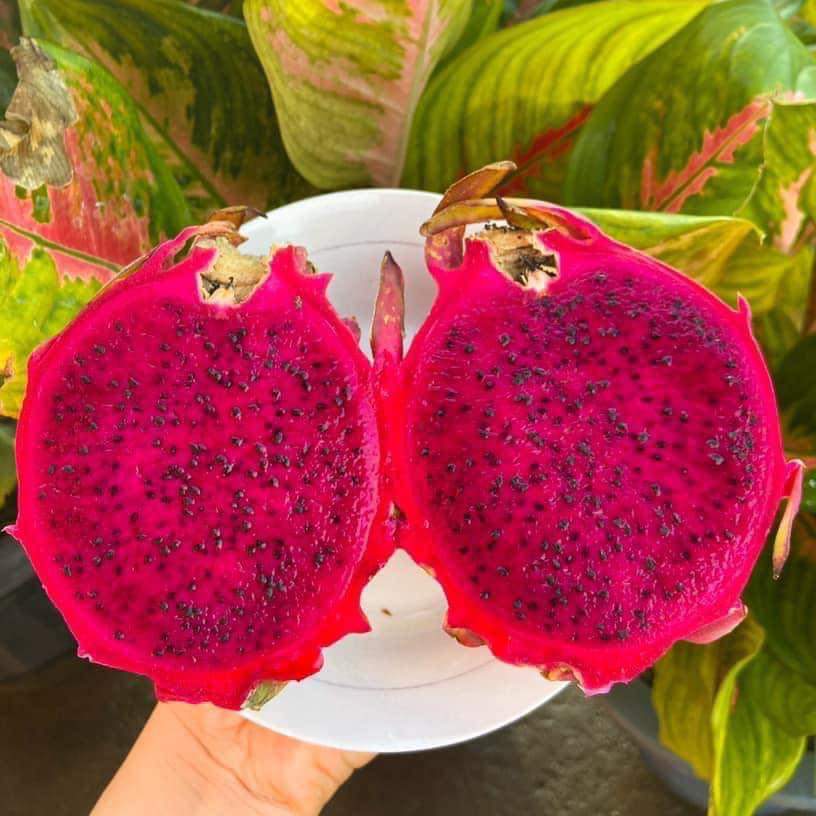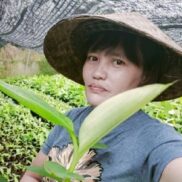Dragon Fruit Variety Selection

This post is also available in:
This post is also available in:
![]() Español (Spanish)
Español (Spanish) ![]() Français (French)
Français (French) ![]() Deutsch (German)
Deutsch (German) ![]() हिन्दी (Hindi)
हिन्दी (Hindi) ![]() العربية (Arabic)
العربية (Arabic) ![]() Türkçe (Turkish)
Türkçe (Turkish) ![]() 简体中文 (Chinese (Simplified))
简体中文 (Chinese (Simplified)) ![]() Português (Portuguese (Brazil))
Português (Portuguese (Brazil)) ![]() polski (Polish)
polski (Polish)
There are many varieties of dragon fruits with different characteristics and commercial importance. Most are classified into 3 different types:
- Hylocereus megalanthus: yellow fruit and whitish flesh and is also known as Pitaya amarilloar yellow pitahaya.
- Hylocereus costaricensis: Red fruit with red-pink flesh is also known as a Pitaya rojaor red-fleshed pitahaya.
- Hylocereus undatus: Pink color fruit with white color flesh and Pithaya blauncaor white-fleshed pitaya.
In the Philippines, two main varieties are grown. The most common is the one with the white flesh, the Hylocereus undatus, followed by a darker red-fleshed dragon fruit, Hylocereus costaricensi. Vietnam mainly grows 3 dragon fruit varieties: white flesh, purple-pink, and red dragon fruit. Purple-pink and red dragon fruits are slightly sweeter than the white flesh variety. Moreover, Vietnamese dragon fruit has substantial potential for the European market.
Different kinds of Dragon fruits
- Sour Dragon Fruit – Stenocereus type of dragon fruit can be found in the dry regions throughout America. It is more popular in the northwestern Mexican region, where people continue to harvest it. It is a refreshing fruit with a spicy and sour taste.
- White Dragon fruit – This is the most widely grown dragon fruit. It has pink skin and white flesh. A Neitzel variety, a Californian native, is sweeter and more delicious when chilled.
- Red Dragon Fruit – It is a sweet-type dragon fruit with red skin and flesh. The texture is comparable to kiwi. It can be eaten raw and also be added to smoothies. The downside to eating red dragon fruit is that it can stain your hands.
- Yellow Dragon Fruit – This dragon fruit variety has a yellow-skinned scaling pattern with firm white flesh, the tastiest. This is native to South America.
Dragon Fruit Varieties
- Alice Dragon Fruit (Hylocereus undatus) – This variety was named for California rare fruit grower member Alice Snow. It is a semi-sweet medium-sized fruit that is typically 0.5-1.0 lbs (0.23-0.45 kg). The outer skin is a brilliant hot pink when the fruit is fully ripe, making it one of the most eye-catching of all the varieties. This variety does, however, need to be Gross-pollinated to set fruit.
- Guyute Dragon Fruit (Hylocereus undatus) – Guyute is a medium to large-sized fruit typically weighing 0.75-1.0 lbs (0.34-0.45 kg). It has a pleasantly sweet taste that is excellent when chilled and eaten fresh. It is self-pollinating and will set fruit on its own.
- Halley’s Comet Dragon Fruit (Hylocereus undatus x polyrhizus) – Halley & RSQUO; S Comet is another hybrid of white-fleshed and red-fleshed fruit. It is incredibly large, typically weighing 1.5-2.0 lbs (0.68-0.9 kg). The fruit is slightly more rounded than the physical graffiti, and the find is more abbreviated. In all other respects, they are nearly identical.
- Harpua Dragon Fruit (Hylocereus undatus) – Harpua is a medium to large fruit typically weighing about one pound. It has a nice snowy white pulp that is semi-sweet and refreshing. The flavor is a mild melon. This variety is self-pollinating.
- L.A. Woman Dragon Fruit (Hylocereus undatus) – This is a highly attractive but relatively useless cultivar. It has a smooth, mild, sweet, refreshing flavor, but it tends to leave a bad taste in your mouth. The fruit is medium to large, typically weighing 0.75-1.5 lbs (0.34-0.68 kg). This variety does need to be cross-pollinated to set fruit, making V. Jaina the preferred alternative for a white-fleshed fruit.
- Lake Atitlan Dragon Fruit (Hylocereus guantemalensis) – This variety is named for a lake in Guatemala that lies among Central American volcanoes. It is a medium to large fruit typically weighing 0.75-1.0 lbs (0.34-0.45 kg). The pulp is flavorful, having a sweet and tangy taste. This variety would best be used as a garnish or combination with other juices. It is self-pollinating.
- Makisupa Dragon Fruit (Hylocereus undatus x polyrhizus) – Makisupa is an excellent magenta-fleshed fruit with a sweet yet slightly astringent taste. The fruit is attractive, having green fins spindled around the pink surface of the fruit. They are medium to large, weighing up to one pound, and this variety is self-pollinating.
- Makisupa Dragon Fruit (Hylocereus undatus x H. polyrhizus) – This variety was introduced to Florida from Thailand, and it is grown on a small scale commercially in Homestead, Florida. It is a consistent producer of dark magenta fleshed fruit that typically weigh one pound. This variety does not require cross or hand-pollination, and it would be a great selection for both homeowners and commercial farms.
- Neitzel Dragon Fruit (Hylocereus undatus)- Neitzel is another selection made by California rare fruit growers. It is a highly attractive white-fleshed fruit with a sweet and appealing flavor. The fruit is medium to large, weighing up to 1 lb (0.45 kg). They are best chilled, eaten fresh, or used as a garnish. This variety is self-pollinating.
- Physical Graffiti Dragon Fruit (Hylocereus undatus x H. polyrhizus) – This variety is a hybrid of red-fleshed and white-fleshed fruit. The result is a remarkably delicious variety that is showy inside and out. This fruit is large, ranging in size from 0.75 – 1.5 lbs (0.34-0.68 kg)
- No cross or hand pollination is needed. This variety is undoubtedly worthy of attention by commercial growers and homeowners alike.
- Purple Haze Dragon Fruit (Hylocereus undatus) – Purple haze is a large sweet fruit with relatively few seeds. It weighs up to two pounds, and they have a pleasant grape, kiwi-alike flavor. This variety is self-pollinating and, like all other magenta-fleshed fruit, does not need other varieties (pollinators) to produce fruits. This variety has commercial value and can be eaten fresh, in juices, or used as a garnish.
- Red Jaina Dragon Fruit (Hylocereus polyrhizus) – Of the varieties, we have at P.I.N. (Pine Island Nursery), this one is the heaviest producer thus far. The fruit is typically 0.5-0.75 lbs (0.23-0.34 kg) with especially dark red flesh. It is semi-sweet and good to eat, but its greatest potential is as a juice variety. The crimson red lycopene-enriched juice could compliment a multitude of tropical drinks, smoothies, or culinary creations. This variety is not self-pollinating and needs to be crossed with another to set fruit.
- Seoul Kitchen Dragon Fruit (Hylocereus undatus) – Seoul Kitchen is a medium to large fruit typically weighing 0.75-1.0 lbs (0.34-0.45 kg). The pulp is smooth and sweet, and it is excellent when chilled and eaten out of hand. This variety is self-pollinating, and it will set fruit without hand pollination.
- Thompson Dragon Fruit (Hylocereus undatus) – Thompson is another selection made by California rare fruit growers. It is a large, robust fruit weighing up to 1.5 pounds (0.68 kg). The pulp is sweet and flavorful, and it is self-pollinating.
- Vietnamese Jaira Dragon Fruit – Vietnam exports more fruits of this variety. The fruit is large, typically weighing 0.5-1.5 lbs (0.23-0.68 kg). It has a sweet snowy flesh, and its impressive size makes this variety so popular among growers and consumers worldwide. This variety is self-pollinating and will set fruit without being hand pollinated.
- Voodoo Child Dragon Fruit (Hylocereus polyrhizus) – Voodoo Child Dragon is a small, sangria-colored fruit that is exceptionally flavorful. The fruit is slightly larger than an egg, and they have a sweet grape-like taste. They are best chilled and eaten fresh or used for juice production (mixed with other juices). This variety is self-pollinating.
- Yellow Dragon Fruit (Hylocereus megalanthus) – This variety is the only one known from the genus Selenicerious. It differs from the Hylocereus in color and harvesting time, and this fruit has thorns that can be found on the fruit itself. The fruit is small to medium, usually weighing 0.5-0.75 lbs (0.23-0.34 kg). The fruit ripens from late November to February, and it is certainly among the sweetest and tastiest of all the Dragon Fruit. This variety is self-pollinating, and it will set fruit on its own.
- Zamorano Dragon Fruit (Hylocereus polyrhizus) – This variety was collected from the Agriculture University in Honduras, from which it took its name. It is a medium to large-sized fruit, typically weighing 0.65-1.0 lbs (0.3-0.45). The flesh is incredibly dark red and has a sweet, mild flavor. Larger fruit size is achieved with hand pollination, but this variety will set fruit on its own. This variety is versatile and can be eaten as fresh fruit, juiced for a drink, or used as a garnish.
References:
- https://www.sciencedirect.com/topics/agricultural-and-biological-sciences/stenocereus
- https://dpi.wi.gov/sites/default/files/imce/school-nutrition/pdf/fact-sheet-dragon-fruit.pdf
- https://www.agmrc.org/commodities-products/fruits/dragon-fruit
- BUSINESS DIARY PH. https://businessdiary.com.ph/9975/enter-dragon-fruit/FRESH PLAZA. https://www.freshplaza.com/europe/article/9428367
- PINE ISLAND NURSERY. https://www.tropicalfruitnursery.com/variety-viewer-vareity-dragon-fruit-reference2
Dragon Fruit: Crop History, Nutritional Value and Uses
Dragon Fruit Plant Information and Environmental Requirements
Dragon Fruit Variety Selection
Soil Requirement and Land Preparation for Dragon Fruit
Dragon Fruit Planting Distances and Trellising
Dragon Fruit Pollination and Propagation
Dragon Fruit tree Training and Pruning
Dragon Fruit Water Requirement and Irrigation Systems








































































